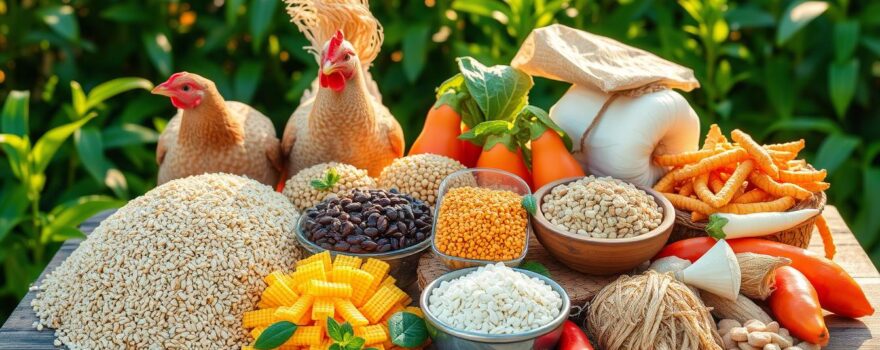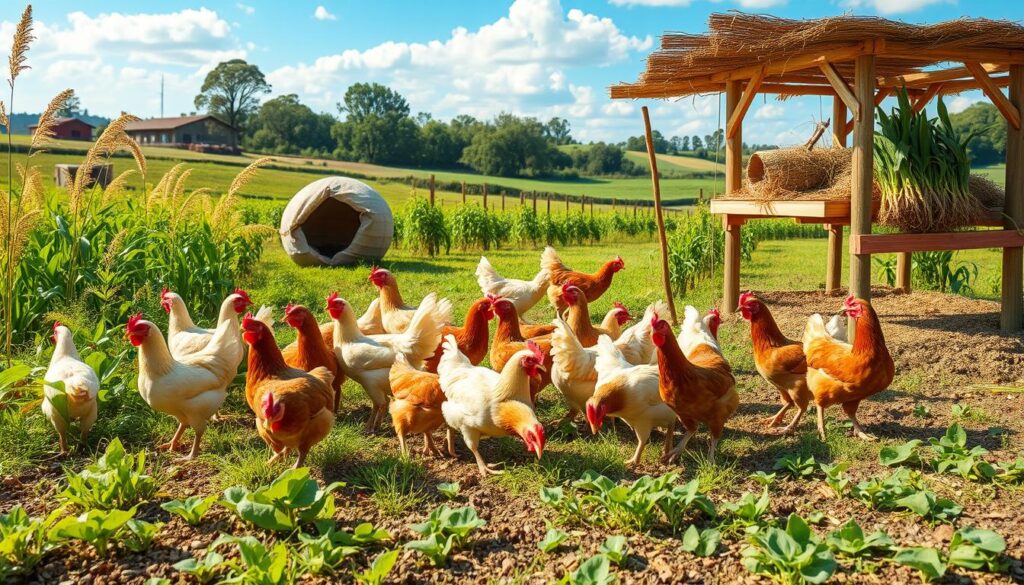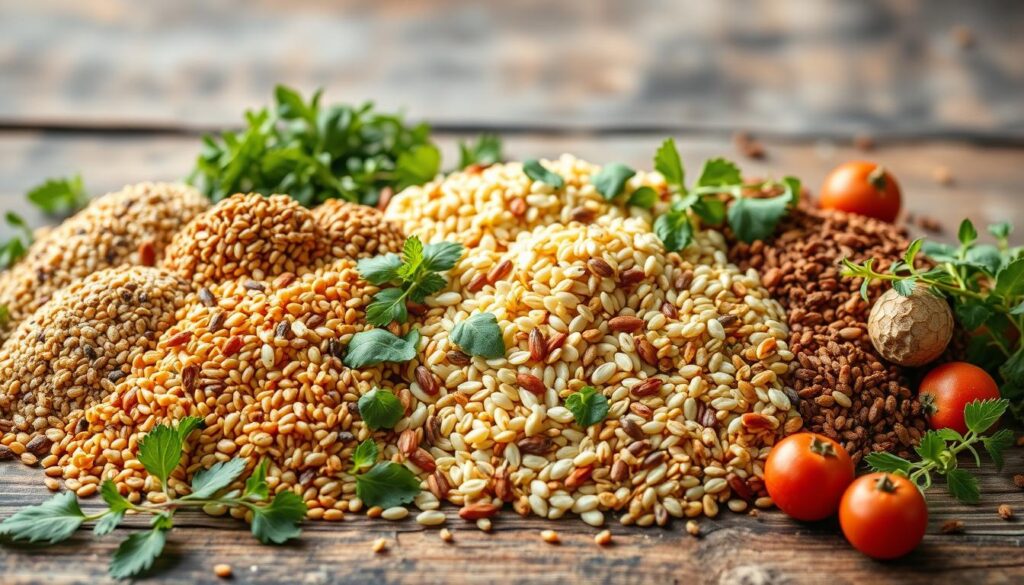
The need for sustainable and local food is on the rise. Poultry farmers are now using local ingredients in their chicken feed. This move helps the local farmers and makes the chicken healthier and more efficient. It also reduces the harm to the environment.
This article talks about the good things and how to use local ingredients in chicken feed. Farmers can find and use local food that is good for their chickens. They can also make sure their chickens are growing well and staying healthy with local food.
Key Takeaways
- Leveraging locally-sourced feed ingredients can reduce the carbon footprint and environmental impact of broiler chicken production.
- Incorporating local feed sources supports the local agricultural community and enhances the self-sufficiency of poultry farms.
- Evaluating the availability and nutritional value of local feed options is crucial for formulating cost-effective and balanced broiler diets.
- Monitoring broiler growth and health parameters is essential for optimizing performance when using locally-sourced feed components.
- Sustainable poultry farming practices, including the use of local feed ingredients, can contribute to a more environmentally-friendly and community-driven food system.
The Benefits of Using Local Ingredients in Broiler Feed
Using local ingredients in broiler chicken feed has many benefits. It’s good for the environment and helps local farmers. By using feed from nearby, producers can lower their carbon footprint and environmental impact.
One big advantage is the reduced greenhouse gas emissions from less transportation. When feed comes from close farms and suppliers, it needs less energy to get to the chickens. This makes a smaller environmental footprint.
Supporting Local Agriculture and Communities
Choosing locally-sourced feed ingredients also helps the local economy and farms. It makes poultry producers more self-sufficient and helps local agriculture grow stronger. This supports thriving rural communities and sustainable poultry farming practices.
- Reduced carbon footprint and environmental impact
- Decreased greenhouse gas emissions from transportation
- Enhanced feed self-sufficiency and resilience of local agriculture
- Support for local farming communities
- Promotion of sustainable poultry farming practices
“By sourcing feed materials from nearby farms and suppliers, poultry producers can minimize the transportation and processing required, lowering greenhouse gas emissions and supporting local agriculture and communities.”
How to Incorporate Local Ingredients into Broiler Chicken Feed
Adding local ingredients to broiler chicken feed is smart and saves money. It helps farmers use what’s available, improve chicken health, and farm sustainably. Here’s how to add local ingredients to your chicken feed:
- Assess the Availability and Nutritional Value of Local Feed Sources – Look at what local farms and suppliers offer. Check if these foods are good for your chickens.
- Formulate Cost-Effective Feed Blends – Mix local ingredients to make feeds that are good for chickens and don’t cost too much. Try different mixes to find the best one.
- Monitor Broiler Performance – Watch how your chickens grow and eat when you use local ingredients. Change the feed if needed to keep them healthy and growing well.
- Explore Natural Broiler Feed Alternatives – Look into using natural, local foods like plants, bugs, or fermented feeds. They can make your chicken diet better and more eco-friendly.
By taking these steps, you can make your chicken feed better and cheaper. This helps your farm grow and be kinder to the planet.
“Incorporating local ingredients into broiler chicken feed is a strategic move that can benefit both the farmer and the environment.”
Evaluating Local Feed Sources and Their Nutritional Value
Poultry farmers need to check local feed sources to improve their chicken feed. They should look at what’s available and when. This helps them make better feed and use less imported stuff, boosting their self-sufficiency.
Assessing Availability and Seasonality
First, farmers need to know when and how much local feed they can get. Things like weather, farming methods, and market trends affect this. They must plan for these changes to keep their chickens well-fed all year.
| Local Feed Ingredient | Availability | Seasonal Variations | Nutritional Profile |
|---|---|---|---|
| Corn | Abundant | Highest availability during harvest season (Fall) | High in carbohydrates, moderate protein content |
| Soybean Meal | Readily available | Consistent year-round supply | Excellent source of protein, contains essential amino acids |
| Alfalfa Hay | Seasonal | Peak availability during spring and summer months | Rich in fiber, vitamins, and minerals |
Knowing when and how much local feed is available helps farmers plan better. They can make sure their chickens get the best nutrients all year.
Cost-Effective Feed Formulations with Local Ingredients
Poultry producers can save a lot by using local ingredients in their chicken feed. They can tap into the rich resources of their region. This makes their operations more self-sufficient and less dependent on imports.
It’s important to check the quality and cost of local feed sources. Look at seasonal changes, nutrient levels, and prices. This way, farmers can make feeds that are both nutritious and affordable for their chickens.
| Locally-Sourced Ingredient | Nutritional Value | Estimated Cost Savings |
|---|---|---|
| Corn | High in carbohydrates, providing energy | Up to 15% reduction in feed costs |
| Soybean Meal | Excellent source of protein | 10-20% reduction in feed costs |
| Wheat Bran | Good source of fiber and minerals | 8-12% reduction in feed costs |
Using local ingredients in feed helps poultry producers. It boosts their self-sufficiency and supports local farmers. This is a win-win for everyone involved.
“Incorporating local feed ingredients has allowed us to significantly reduce our feed costs, while also supporting the farmers in our community.”
Optimizing Broiler Performance with Locally-Sourced Feed
Using locally-sourced ingredients in broiler chicken feed is key to better performance. It boosts growth, feed efficiency, and health. Farmers can use regional resources to improve their flock’s health and growth.
Monitoring Growth and Health Parameters
It’s vital to watch key growth and health signs to ensure the feed meets broilers’ needs. This includes:
- Body weight and weight gain
- Feed intake and feed conversion ratio
- Mortality rate
- Incidence of common health issues
By tracking these, farmers can tweak the feed and management to boost performance. This also keeps broiler chicken nutrition at its best.
| Parameter | Baseline | Locally-Sourced Feed |
|---|---|---|
| Average Daily Gain (g/day) | 60 | 65 |
| Feed Conversion Ratio | 1.8 | 1.6 |
| Mortality Rate (%) | 4 | 3 |
The table shows the real benefits of using local feed. It improves growth, feed use, and cuts down on death rates.
“Carefully monitoring the growth and health parameters of broilers is crucial to ensuring that the locally-sourced feed is meeting their nutritional needs and delivering optimal performance.”
By using local feed, farmers can make their broiler operations more productive and sustainable. They also support the local farming community.
Sustainable Poultry Farming Practices
Sustainable poultry farming is key to reducing the environmental impact of the industry. By using locally-sourced ingredients in broiler chicken feed, farmers help the environment and support local agriculture. This makes feed production more eco-friendly and community-focused.
One big advantage of sustainable poultry farming is the lower carbon footprint. Locally-sourced feed means less transportation and processing. This cuts down on greenhouse gas emissions from feed production, helping to fight climate change.
Also, using local feed ingredients boosts the local economy and communities. Farmers connect better with their neighbors, building a stronger community. This approach supports sustainable development, benefiting both the environment and local people.
| Sustainable Poultry Farming Practices | Benefits |
|---|---|
| Incorporating locally-sourced feed ingredients |
|
| Promoting on-farm feed production |
|
| Implementing sustainable waste management practices |
|
Sustainable poultry farming, like using local feed, helps the environment and builds a better food system. By adopting these practices, poultry farmers are crucial in creating a sustainable and community-focused future for the industry.

Enhancing Feed Self-Sufficiency through Local Sourcing
Poultry producers are looking for ways to improve their operations. One strategy is using local ingredients for broiler chicken feed. This approach helps make feed production more self-sufficient and cost-effective.
Reducing Reliance on Imported Feed Components
Imported feed ingredients can be expensive and add to the complexity of supply chains. This can hurt the bottom line of poultry farms. By using local agricultural products, producers can reduce their dependence on imported components and support their local economies.
This change makes the feed supply chain simpler. It also helps meet the industry’s goals for sustainability.
| Benefits of Local Sourcing | Drawbacks of Relying on Imported Feed |
|---|---|
|
|
By using local ingredients in their feed, poultry producers can enhance feed self-sufficiency. They also promote cost-effective and sustainable practices in their operations.
Natural Broiler Feed Alternatives from Local Sources
In the quest for sustainable poultry farming, smart broiler producers are looking into natural feed options. They use ingredients from local farms. This move supports local farmers and cuts down on environmental harm.
Using grains like sorghum, millet, and triticale in broiler feed is a good idea. These grains are full of nutrients and support sustainable poultry farming. Legumes, such as soybeans, field peas, and lentils, also add protein to the diet.
Broiler farmers are also using locally-sourced feed ingredients from farm waste. For example, they use spent brewers’ grains and waste from fruit and vegetable processing. This not only cuts down on waste but also provides natural broiler feed alternatives that are good for broiler chicken nutrition.
- Locally-grown grains such as sorghum, millet, and triticale
- Locally-sourced legumes like soybeans, field peas, and lentils
- Agricultural by-products such as spent brewers’ grains, distillers’ dried grains, and fruit/vegetable processing waste
By choosing these natural broiler feed alternatives, farmers can make their feed better for the birds. It also makes their farming more sustainable. This helps local farms and reduces the environmental impact of raising broiler chickens.

“Embracing locally-sourced feed ingredients is a game-changer in the pursuit of sustainable poultry farming, allowing us to nourish our broilers while nurturing the land and communities we’re a part of.”
Broiler Chicken Nutrition and the Role of Local Ingredients
Improving broiler chicken performance begins with giving them the right food. Using local feed ingredients is key. This ensures the birds get a diet that supports their growth and health.
Meeting Nutritional Requirements
Broiler chickens need a special mix of nutrients for fast growth. This includes proteins, carbs, fats, vitamins, and minerals. Local feed ingredients can provide these essential nutrients.
For example, corn and wheat from local farms offer energy. Soybean meal and animal by-products help with muscle growth. Vitamin and mineral supplements from nearby farms also play a crucial role in their health.
| Nutrient | Requirement for Broilers | Examples of Local Ingredients |
|---|---|---|
| Protein | 20-24% of total diet | Soybean meal, locally-sourced animal by-products |
| Energy (Carbohydrates and Fats) | 3,200-3,400 kcal/kg | Corn, wheat, locally-grown oilseeds |
| Vitamins and Minerals | Specific requirements for each micronutrient | Locally-produced vitamin and mineral supplements |
Matching local feed ingredients with broiler chicken needs is vital. This approach ensures a balanced and healthy diet for the birds.
Supporting Local Agriculture and Reducing Environmental Footprint
Using local ingredients in broiler chicken feed helps poultry producers. It supports local farms and cuts down on environmental harm. This way of farming is good for the planet and the community.
Buying feed from nearby farms boosts the local economy. It also cuts down on carbon emissions from long trips. This makes poultry farming more eco-friendly. Plus, using local ingredients makes farms less dependent on outside feed, making them more sustainable.
Choosing local feed for chickens also helps the community. It strengthens ties with the area and boosts the local economy. This partnership makes the food system stronger and benefits everyone involved.